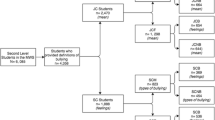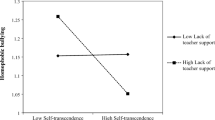Abstract
The aim of the present study was to explore how teenagers explain why bullying takes place at school, and whether there were any differences in explaining bullying due to gender and prior bullying experiences. One hundred and seventy-six Swedish students in Grade 9 responded to a questionnaire. Mixed methods (qualitative and quantitative methods) were used to analyze data. The grounded theory analysis generated five main categories and 26 sub categories regarding accounts of bullying causes. Results indicated that youth tended to explain bullying in terms of individualistic reasons (bully attributing and victim attributing) than in terms of peer group, school setting, or human nature/society reasons. Girls were more likely to attribute bullying causes to the bully and much less to the victim, compared to boys. Moreover, youth classified as bullies were more likely to attribute the reason for bullying to the victim and much less to the bully, compared to victims, bystanders, and victims/bullies.
Similar content being viewed by others
References
Bandura, A. (2002). Selective moral disengagement in the exercise of moral agency. Journal of Moral Education, 31, 101–119.
Becker, H. S. (1963). Outsiders: Studies in the sociology of deviance. New York: The Free Press of Glencoe.
Besag, V. E. (2006). Understanding girls’ friendships, fights and feuds: A practical approach to girls’ bullying. New York: Open University Press.
Blumer, H. (1969). Symbolic interactionism. Berkeley: University of California Press.
Borich, G. D. (2007). Effective teaching methods: Research-based practice (6th ed.). Upper Saddle River, NJ: Pearson.
Borntrager, C., Davis, J. L., Bernstein, A., & Gorman, H. (2009). A cross-national perspective on bullying. Child & Youth Care Forum, 38, 121–134.
Bosacki, S. L., Marini, Z. A., & Dane, A. V. (2006). Voices from the classroom: Pictorial and narrative representations of children’s bullying experiences. Journal of Moral Education, 35, 231–245.
Buchanan, P., & Winzer, M. (2001). Bullying in schools: Children’s voices. International Journal of Special Education, 16, 67–79.
Bukowski, W. M., & Sippola, L. K. (2001). Groups, individuals, and victimization: A view of the peer system. In J. Juvonen & S. Graham (Eds.), Peer harassment in school (pp. 3–20). New York: The Guilford Press.
Burns, S., Maycock, B., Cross, D., & Brown, G. (2008). The power of peers: Why some students bully others to conform. Qualitative Health Research, 18, 1704–1716.
Charmaz, K. (2006). Constructing grounded theory. London: Sage Publications.
Charon, J. M. (2007). Symbolic interactionism: An introduction, an interpretation, an integration (9th ed.). New Jersey: Upper Saddle River.
Crick, N. R., & Dodge, K. A. (1994). A review and reformulation of social information-processing mechanisms in children’s social adjustment. Psychological Bulletin, 115, 74–101.
Deaux, K., & Philogène, G. (Eds.). (2001). Representations of the social. Oxford: Blackwell.
Dijkstra, J. K., Lindenberg, S., & Veenstra, R. (2008). Beyond the class norm: Bullying behavior of popular adolescents and its relation to peer acceptance and rejection. Journal of Abnormal Child Psychology, 36, 1289–1299.
Dodge, K. A., Coie, J. D., & Lynam, D. (2006). Aggression and antisocial behavior in youth. In N. Eisenberg, D. William, & R. M. Lerner (Eds.), Handbook of child psychology. Vol. 3: Social, emotional, and personality development (6th ed., pp. 719–788). New Jersey: Wiley.
Duffy, A. L., & Nesdale, D. (2009). Peer groups, social identity, and children’s bullying behavior. Social Development, 18, 122–139.
Erling, A., & Hwang, C. P. (2004). Swedish 10-year-old children’s perceptions and experiences of bullying. Journal of School Violence, 3, 33–43.
Eslea, M., Menesini, E., Morita, Y., O’Moore, M., Mora-Merchán, J. A., Pereira, B., et al. (2003). Friendship and loneliness among bullies and victims: Data from seven countries. Aggressive Behavior, 30, 71–83.
Field, A. (2005). Discovering statistics using SPSS (2nd ed.). London: Sage.
Fiske, S. T., & Taylor, S. E. (2008). Social cognition: From brains to culture. New York: McGraw-Hill.
Frisén, A., Holmqvist, K., & Oscarsson, D. (2008). 13-year-olds’ perception of bullying: Definitions, reasons for victimisation and experience of adults’ response. Educational Studies, 34, 105–117.
Frisén, A., Jonsson, A.-K., & Persson, C. (2007). Adolescents’ perception of bullying: Who is the victim? Who is the bully? What can be done to stop bullying? Adolescence, 42, 749–761.
Gifford-Smith, M., & Rabiner, D. L. (2004). Social information processing and children’s social competence: A review of the literature. In J. Kupersmidt & K. A. Dodge (Eds.), Children’s peer relations: From development to intervention to policy (pp. 61–79). Washington, DC: American Psychological Association.
Gini, G. (2008). Italian elementary and middle school students’ blaming the victim of bullying and perception of school moral atmosphere. The Elementary School Journal, 108, 335–354.
Gini, G., Pozzoli, T., Borghi, F., & Franzoni, L. (2008). The role of bystanders in students’ perception of bullying and sense of safety. Journal of School Psychology, 46, 617–638.
Glaser, B. G. (1978). Theoretical sensitivity. San Francisco: The Sociology Press.
Goffman, E. (1963). Stigma. New York: Simon & Schuster.
Hamarus, P., & Kaikkonen, P. (2008). School bullying as a creator of pupil pressure. Educational Research, 50, 333–345.
Hara, H. (2002). Justifications for bullying among Japanese schoolchildren. Asian Journal of Social Psychology, 5, 197–204.
Hazler, R. J., & Hoover, J. H. (1993). What do kids say about bullying? Education Digest, 58, 16–20.
Hoffman, M. L. (2000). Empathy and moral development: Implications for caring and justice. Cambridge: Cambridge University Press.
Hoover, J. H., Oliver, R., & Hazler, R. J. (1992). Bullying: Perceptions of adolescent victims in the Midwestern USA. School Psychology International, 13, 5–16.
HSFR. (2009). Forskningsetiska principer inom humanisk-samhällsvetenskap forskning [Code of conduct for humanities and social sciences research]. Retrieved from Swedish Research Council website: http://www.codex.vr.se/texts/HSFR.pdf.
Hymel, S., Rocke-Henderson, N., & Bonanno, R. A. (2005). Moral disengagement: A framework for understanding bullying among adolescents. Special Issue of Journal of Social Sciences, 8, 1–11.
Kelle, U. (2007). The development of categories: Different approaches in Grounded Theory. In A. Bryant & K. Charmaz (Eds.), The SAGE handbook of Grounded Theory (pp. 191–213). Los Angeles: Sage Publications.
Kless, S. J. (1992). The attainment of peer status: Gender and power relationships in the elementary school. Sociological Studies of Child Development, 5, 115–148.
MacDonald, H., & Swart, E. (2004). The culture of bullying at a primary school. Education as Change, 8, 33–55.
Menesini, E., Esla, M., Smith, P. K., Genta, M. L., Giannetti, E., Fonzi, A., et al. (1997). A cross-national comparison of children’s attitudes towards bully/victim problems in school. Aggressive Behavior, 29, 1–13.
Merton, D. E. (1994). The cultural context of aggression: The transition to junior high school. Anthropology & Education Quarterly, 25, 29–43.
Mishna, F., Weiner, J., & Pepler, D. (2008). Some of my best friends: Experiences of bullying within friendships. School Psychology International, 29, 549–573.
Moscovici, S. (2001). Social representations: Explorations in social psychology. Cambridge: Cambridge University Press.
Neal, J. W. (2007). Why social networks matter: A structural approach to the study of relational aggression in middle childhood and adolescence. Child & Youth Care Forum, 36, 195–211.
Nucci, L. (2006). Education for moral development. In M. Killen & J. Smetana (Eds.), Handbook of moral development (pp. 657–681). Mahwah, NJ: Lawrence Erlbaum Associates.
O’Connell, P., Pepler, D., & Craig, W. (1999). Peer involvement in bullying: Insights and challenges for intervention. Journal of Adolescence, 22, 437–452.
Olweus, D. (1993). Bullying at school. Malden, MA: Blackwell.
Owens, L., Shute, R., & Slee, P. (2000). “Guess what I just heard!”: Indirect aggression among teenage girls in Australia. Aggressive Behavior, 26, 67–83.
Phelan, J. O., & Link, B. G. (1999). The labelling theory of mental disorder (1): The role of social contingencies in the application of psychiatric labels. In A. V. Horwitz & T. L. Scheid (Eds.), A handbook for the study of mental health: Social contexts, theories, and systems (pp. 139–149). Cambridge: Cambridge University Press.
Phoenix, A., Frosh, S., & Pattman, R. (2003). Producing contradictory masculine subject positions: Narratives of threat, homophobia and bullying in 11–14 year old boys. Journal of Social Issues, 59, 179–195.
Rigby, K. (1996). Bullying in schools and what we can do about it. London: Jessica Kingsley.
Rigby, K., & Slee, P. T. (1993). Dimensions of interpersonal relation among Australian children and implications for psychological well-being. Journal of Social Psychology, 133, 33–42.
Ringrose, J. (2008). ‘Just be friends’: Exposing the limits of educational bully discourses for understanding teen girls’ heterosexualized friendships and conflicts. British Journal of Sociology of Education, 29, 509–522.
Salmivalli, C. (2010). Bullying and the peer group: A review. Aggression and Violent Behavior, 15, 112–120.
Salmivalli, C., Lagerspetz, K., Björkqvist, K., Östermalm, K., & Kaukiainen, A. (1996). Bullying as a group process: Participant roles and their relations to social status within the group. Aggressive Behavior, 22, 1–15.
Salmivalli, C., & Voeten, M. (2004). Connections between attitudes, group norms, and behaviour in bullying situations. International Journal of Behavioral Development, 28, 246–258.
Stoudt, B. G. (2006). “You’re either in or you’re out”: School violence, peer discipline, and the (re)production of hegemonic masculinity. Men and Masculinities, 8, 273–287.
Teräsahjo, T., & Salmivalli, C. (2003). “She is not actually bullied”: The discourse of harassment in student groups. Aggressive Behavior, 29, 134–154.
Terranova, A. M. (2009). Factors that influence children’s responses to peer victimization. Child & Youth Care Forum, 38, 253–271.
Thornberg, R. (2006). The situated nature of preschool children’s conflict strategies. Educational Psychology, 26, 109–126.
Thornberg, R. (2010a). A student in distress: Moral frames and bystander behavior in school. The Elementary School Journal, 110, 585–608.
Thornberg, R. (2010b). Schoolchildren’s social representations on bullying causes. Psychology in the Schools, 47, 311–327.
Thornberg, R. (in press). “She’s weird!”—the social construction of bullying in school: A review of qualitative research. Children & Society (forthcoming).
Trach, J., Hymel, S., Waterhouse, T., & Neale, K. (2010). Bystander responses to school bullying: A cross-sectional investigation of grade and sex differences. Canadian Journal of School Psychology, 25, 114–130.
Varjas, K., Meyers, J., Bellmoff, L., Lopp, E., Birckbichler, L., & Marshall, M. (2008). Missing voices: Fourth through eight grade urban students’ perceptions of bullying. Journal of School Violence, 7, 97–118.
Wright, J. C., Giammarino, M., & Parad, H. W. (1986). Social status in small groups: Individual–group similarity and the social “misfit”. Journal of Personality and Social Psychology, 50, 523–536.
Author information
Authors and Affiliations
Corresponding author
Additional information
This study was a part of a Swedish research project, “School bullying as a social process”, supported in part by grants from the Swedish Research Council.
Rights and permissions
About this article
Cite this article
Thornberg, R., Knutsen, S. Teenagers’ Explanations of Bullying. Child Youth Care Forum 40, 177–192 (2011). https://doi.org/10.1007/s10566-010-9129-z
Published:
Issue Date:
DOI: https://doi.org/10.1007/s10566-010-9129-z




